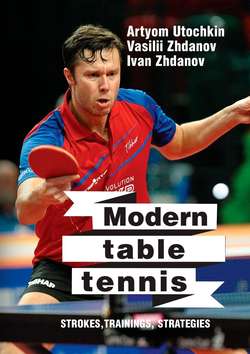Читать книгу Modern table tennis: strokes, trainings, strategies - Artyom Utochkin - Страница 6
Chapter 1. Modern table tennis
History of service changing in table tennis
ОглавлениеWith a good tradition, formed in the last chapters, let’s take a look at the history. At the dawn of the table tennis on international arena serving really was just putting the ball into the game. This was due to the general rudimentary level of table tennis development in that period, both in terms of the game, and in terms of the equipment used.
With the progress in the blade and rubber production for table tennis, all the elements became more complicated. Serves weren’t left behind. In the late 50’s and early 60’s, Japanese and Chinese tennis players began to make heavy services with a spin.
Further, the level of services grew, more and more tennis players began to use service with the spin. Serve was no longer just the introduction of the ball into the game, but a formidable weapon in the hands of good masters.
In the 70’s, the serving complexity began to increase due to the imperfection of table tennis rules. At that time, the height of the ball throwing was not indicated (now it is 16 cm) and many tennis players began to serve “from hand”.
If you play table tennis for at least a year or two, you perfectly understand how difficult the service can be if you do not throw the ball, but throw it right away on the racket. Hand service can be compared with a goal from offside, when the rules do not prohibit it the chaos begins in the game.
A number of top-level tennis players went even further. They did not just serve the ball from the hand, but they also added an extra spin due to the fingers of the hand that threw the ball. As a result, the atomic mixture was obtained, and it was very difficult to cope with the service.
The peak of such service development was reached by the end of the 70’s, after which the International Table Tennis Federation (ITTF) changed the rules, adjusting the service rules.
Now it was necessary to throw the ball no less than 16 cm high and perform at an angle of at least 45 degrees – it is compliance with this angle does not allow to throw the ball immediately on the racket, giving it an additional impulse in the form of acceleration or spin. Also, it was set up in the rules that since now athletes can throw the ball only with an open palm. If the ball is thrown by the fingers, then a point was taken from the player.
The introduction of these rules ended the era of services, the complexity of which was created due to the lack of clear rules. And although the transition was gradual, still many continued to serve, not strongly adhering to the rules, and a number of umpires weren’t too strict and closed their eyes to those moments: with the change of generations, these serves have gone down in history.
Since the mid 80’s, services began to develop in a different direction. They became more difficult, but now the athletes were looking for complexity in other aspects.
At present, the main three components of a service are: the ball processing technique, which has been constantly improved, the position in front of the table and the ability to cover the moment of touching the ball and racket with the left hand and core.
Now the athletes began to use the forehand service more often. At the same time, they approached the table with their left side to hide the moment of touching the ball and racket.
The peak of complexity development of services performed in this way was reached in the mid-90’s. Outstanding masters of that time were Jan-Ove Waldner and today’s coach of the China men’s national team Liu Guoliang.
Those who play table tennis for a long time, remember that at that time the set was played up to 21 points and with 5 services.
In those years service complexity reached such a level that a series of five services became an analogy to the home serve game in tennis. If one lost his series of serves
2:3, and then the opponent converted his series 4:1 then you already lose 7:3. Another unsuccessful series of home serves and chances to win the set are miserable.
The services were so complex that in a series of 5 services there could be 2 errors immediately on return and 2 more passive returns that allowed the server to win the next point in the same manner.
The International Table Tennis Federation believes that complex services to some extent limit the possibility of a long rally and this affects the spectacularity of the sport.
Beginning from the late 90’s, the topic of a new round of changes in the service rules was actively discussed. As a result, in 2002, the new rules forbade hiding from the opponent the moment of touching the ball and racket with a hand or body.
As a result, at the beginning complexity of the services fell dramatically, but it lasted a year; and then with the full connivance of the umpires, the athletes began to cover the ball with the core, hiding the moment of touch of racket and ball.
Thus, the International Federation did not succeed, in weakening the influence of the service on the rally. Serves at a high level remained very complex.
And at the moment when these lines are being written, a new storm of discussion has begun in the world concerning the weakening the influence of the serve on the rally. One of the options that is now actively discussed is the complete transition to the backhand serve. If this happens, then it will be a very dramatic change.
